 In his current role, he oversees the industrial companies that come to ISIS. Whether companies need beam-time, make use of our lab facilities, or help to commercialise our technologies, Graham is often at the start and end of these processes. Day to day this means he is moving between a lot of activities, from attending events to attract businesses, to giving tours of the facility, producing case studies and developing impact from the industrial experiments.
In his current role, he oversees the industrial companies that come to ISIS. Whether companies need beam-time, make use of our lab facilities, or help to commercialise our technologies, Graham is often at the start and end of these processes. Day to day this means he is moving between a lot of activities, from attending events to attract businesses, to giving tours of the facility, producing case studies and developing impact from the industrial experiments.
Graham uses his expertise in facility capabilities to offer consultation and, while building connections with companies, makes them aware of how ISIS can be useful to their research and development. As well as this, Graham advises companies, whose needs may be more suited to other characterisation experiments, to talk to the Diamond light source, Central Laser Facility or other STFC departments. (So, not only is he an ISIS facility expert, but he also has knowledge about the huge array of other scientific capabilities at the Rutherford Appleton Laboratory.) From here, he assists companies further by finding the correct instrument, discussing feasibility with a scientist and applying for beamtime through the various routes, each to the specific requirements of that company.
These industrial users produce some of the best examples of real-world impacts ISIS has to offer. From aeroplane wings to drug delivery, the industrial users who access ISIS have to demonstrate their potential benefit to the UK. For example, experiments looking at reducing friction in engines via the lubricants used, could lead to a 5% friction reduction, which would reduce the CO2 emissions by 50 million tonnes per year! These examples allow ISIS to ensure its beam-time is used to its fullest potential for optimal impact.
Graham's career is a fascinating one that sent him to almost all of the radiation facilities across Europe. Raised and educated up to PhD level in New Zealand, he studied under one of New Zealand's most famous scientists, Sir Paul Callaghan, who set up the MacDiarmid Institute for Advanced Materials and Nanotechnology. “It was Paul who advised me to pursue physics over chemistry - completely unbiasedly obviously!" says Graham. “So, I moved into a PhD focused on development of novel thermal neutron imaging plates and was able to test them at TU Delft and at the Paul Scherrer Institute (PSI) in Switzerland. Those were the first ticks on my European facility checklist."

Graham moved to Germany for his Postdoc, based on luminescent X-ray detectors. Having used DESY, (the German synchrotron in Hamburg) to characterise his detectors, he later decided to apply for an industry liaison role there. This further expanded his knowledge of X-ray techniques as he brought businesses from around the Baltic Sea to perform experiments in Hamburg. A few years later, he coordinated a Horizon 2020 project at European XFEL, bringing together of all the X-ray facilities across Europe including synchrotrons, Free Electron Lasers and optical laser facilities. During this time, Graham was able to visit and collaborate with facilities in France, Italy and Sweden among others, collating knowledge of X-ray techniques and industrial liaison practices.

A couple of years later, all of the project management and industrial experience Graham had picked up along the way allowed him to be amazed as he came across the job advert for Business Development Manager of ISIS, “it was perfect, my CV was on the job description!" he says. So, in September 2019, he moved from Germany to the UK to work on our industrial engagement.
Having only moved to the UK three years ago, Graham loves to explore the country, even stating that his favourite place is on a cliffside walk, anywhere by a coast, especially with a castle. Along with this, comes his other hobbies, entertaining his puppy and maintaining his two challenging garden ponds (with pumps, filters and monitors for pH, nitrates and who knows what else). As well as this, he has been striving to learn Russian since 2015 so, привет Graham!
Rapid Fire Questions:
- What did you want to be when you grew up? – An astronaut.
- Who is your favourite scientist? – Rutherford, as he was also from New Zealand.
- What is a good book you have read recently? - The Hail Mary Project, about space travel.
- If you had a time machine when/where would you go? – I've always been interested in medieval castles and knights, but to live back then would not have been fun. So I think I would see the future, in 50-100 years and see what state we are in.
- Where is your favourite place? - Coastal walks. Cliffs by the sea, preferably with castles
- What superpower would you want? - Super fast healing
- You can solve 1 problem, what do you choose? - Reducing carbon emissions to help the world reach net zero without much disruption.
- If you were an animal, what would you be? - A cat in a loving house. My cat when it rains, has breakfast and then just goes back to sleep. I think that's a great life.
